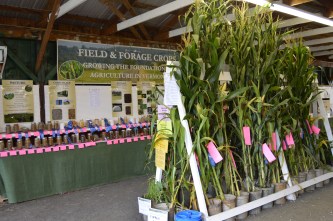As we all know, this is a challenging year for successfully planting and harvesting crops in the Champlain Valley and beyond. As a group of agronomists, we often talk about the timeliness of planting and harvesting crops as they relate to crop yield, quality, and protecting soil health. That said, at the end of the day, the real challenge will be how to feed those crops to your animals successfully. This year, more than most, forage analysis will be very important. You will need to take a close look at your forage quality and make adjustments to your other feed stocks accordingly.
Dr. Leonard Bull shared some great advice and information for us about how forage quality this year may impact how those forages are fed out and how you make up the differences:
Delayed first cutting of grass and legume forages in the Northeast results in a steady decline in digestibility of the forage. And while yields may go up, the extra tons of dry matter are not much advantage if digestibility is lower and inert gut fill greater. The average decline is about 0.5-0.7 percentage units per day in total digestible nutrients (TDN). In addition, protein content declines by about 0.1 percent per day of delay. Combined, if these are the only forages fed to dairy cows the total diet will need about 1 percent more concentrate of higher protein content for every day of delayed harvest.
In addition to perennial forages, the delayed planting we experienced this year in Vermont can affect the quality of annual forages like corn silage. A lot of corn is going to have lower energy values unless we see a major turnaround soon. Again, concentrates will need to be adjusted accordingly.
Dr. Leonard S. Bull, Ph.D., PAS * Emeritus Professor of Animal Science North Carolina State University * New Haven, Vermont
Forage Sampling & Analysis
Proper forage sampling is important. As the saying goes, garbage in equals garbage out. Your goal is to collect a representative sample of the total volume being sampled. Penn State Extension has a great fact sheet on the subject: Forage Quality Testing: Why, How, and Where (Agronomy Facts 44). Some highlights are listed below.
- Collect a representative sample. This includes collecting multiple sub-samples, mixing them together thoroughly, and then taking your sample for analysis from this larger sample. For instructions on how to sample by type of forage and whether you are sampling at harvest or after it has been stored, visit this helpful resource from Penn State University Extension.
- Store and ship samples appropriately. Be sure and use the recommendations provided by the lab, but as a general rule of thumb, you should keep dry hay samples in a cool place and haylage and silage samples frozen in an airtight container. Mail the sample in an insulated bag—preferably early in the week—to prevent bacterial decay that might alter the results.
- Select a laboratory with proper analysis and protocol. Use a certified lab that participates in a proficiency testing program like the National Forage Testing Association and uses duplicate/quality control check samples. If you are using near infrared reflectance spectroscopy (NIRS), make sure they are calibrating appropriately with chemical analysis periodically. While we do not endorse any particular lab, some local labs that meet these criteria are Dairy One and Cumberland Valley Analytical Services.
- Fill out the lab forms completely and accurately. This is especially important when using NIRS analysis so that the proper calibration is selected for your forage (i.e., corn silage versus haylage).
- Know how to read your forage analysis report. Once you receive your results, be sure and take a close look and review your results with your animal nutritionist, veterinarian, consultant or extension advisor. There is a great document from Cornell Extension, that helps decipher a forage analysis report here.
As always, if you need more information or would like assistance please don’t hesitate to contact us:
UVM Extension * Champlain Valley Crop, Soil & Pasture Team
(802) 388-4969















